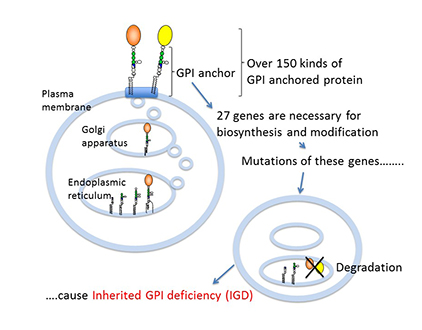- Home
- For Patients
- 1.What causes inherited GPI deficiency (IGD)?
Q1.What causes inherited GPI deficiency (IGD)?
A1.All human tissues, such as brain, heart, muscle, and skin, consist of tissue-specific cells, and over 20,000 different proteins are synthesized from genes within those cells. These proteins are localized in organelles, the cytoplasm, and the cell membrane and have many important roles. Among the various proteins on the cell membrane, there is a group of over 150 proteins called GPI-anchored proteins (GPI-APs), which have a common structure; an example of a GPI-AP is alkaline phosphatase (ALP). GPI anchors are glycolipids that anchor these important proteins to the cell membrane; the GPI anchor and the protein with which it associates are separately synthesized, combined, and transported to the cell surface. Twenty-seven genes are known to be necessary for GPI-AP synthesis. A complete defect in one of these genes causes loss of all of these important proteins from the cell surface, leading to embryonic death. IGD is caused by the mutation of these genes, leading to decreased expression of GPI-APs.

GPI-APs are synthesized in the endoplasmic reticulum (ER) through various complex steps. The genes involved in the biosynthesis of GPI anchors in the ER are called PIG genes (from PIGA to Z). After a GPI anchor attaches to a precursor protein, GPI-APs are further modified in the ER and in the Golgi apparatus and transported to the cell surface. The genes involved in modifying GPI-APs are called PGAP genes (from PGAP1 to 5). Inherited GPI deficiency (IGD) is a disease caused by a mutation in one of these genes. As complete GPI deficiency causes embryonic death, most IGD patients have partial GPI deficiencies. To date, 18 kinds (within 27 different causative genes) of IGD have been reported.
Return to the previous page







